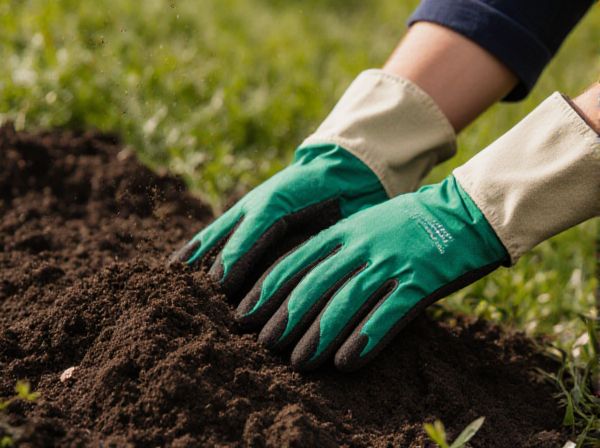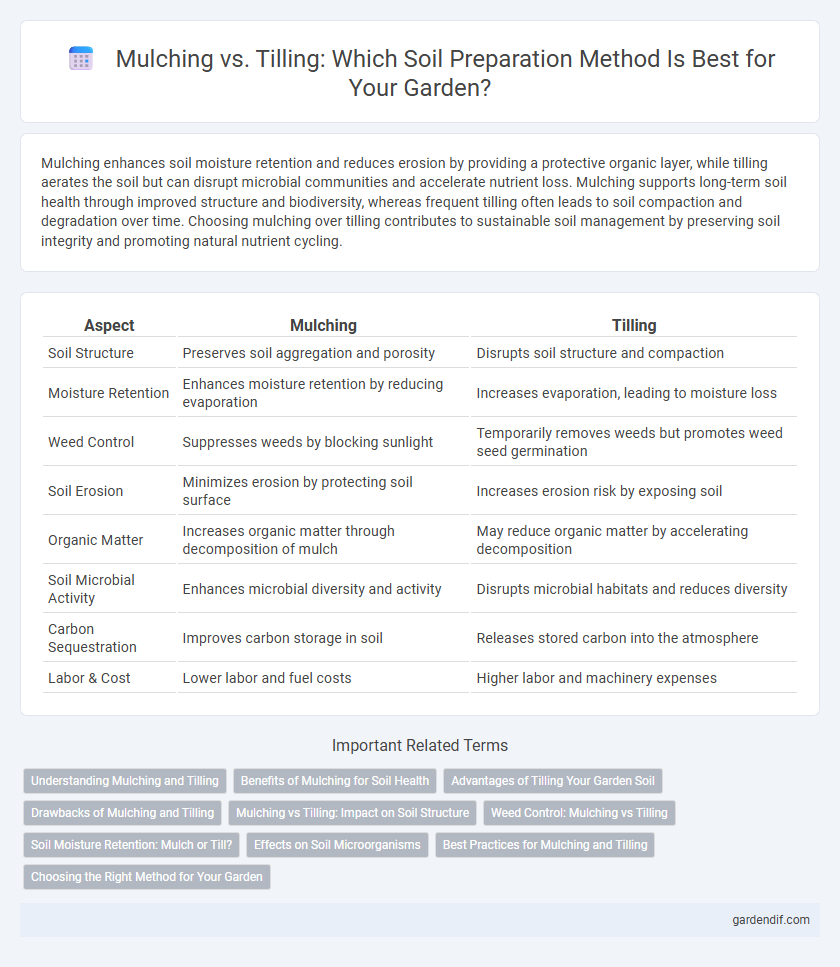
Mulching vs Tilling Illustration
Mulching enhances soil moisture retention and reduces erosion by providing a protective organic layer, while tilling aerates the soil but can disrupt microbial communities and accelerate nutrient loss. Mulching supports long-term soil health through improved structure and biodiversity, whereas frequent tilling often leads to soil compaction and degradation over time. Choosing mulching over tilling contributes to sustainable soil management by preserving soil integrity and promoting natural nutrient cycling.
Table of Comparison
| Aspect | Mulching | Tilling |
|---|---|---|
| Soil Structure | Preserves soil aggregation and porosity | Disrupts soil structure and compaction |
| Moisture Retention | Enhances moisture retention by reducing evaporation | Increases evaporation, leading to moisture loss |
| Weed Control | Suppresses weeds by blocking sunlight | Temporarily removes weeds but promotes weed seed germination |
| Soil Erosion | Minimizes erosion by protecting soil surface | Increases erosion risk by exposing soil |
| Organic Matter | Increases organic matter through decomposition of mulch | May reduce organic matter by accelerating decomposition |
| Soil Microbial Activity | Enhances microbial diversity and activity | Disrupts microbial habitats and reduces diversity |
| Carbon Sequestration | Improves carbon storage in soil | Releases stored carbon into the atmosphere |
| Labor & Cost | Lower labor and fuel costs | Higher labor and machinery expenses |
Understanding Mulching and Tilling
Mulching involves covering soil with organic materials such as straw, leaves, or wood chips to retain moisture, regulate temperature, and suppress weeds, which enhances soil structure and microbial activity. Tilling mechanically breaks and aerates the soil, helping to incorporate organic matter and control weed growth, but excessive tilling can disrupt soil ecosystems and lead to erosion. Understanding the benefits and limitations of both practices is essential for optimizing soil health and sustainable crop production.
Benefits of Mulching for Soil Health
Mulching improves soil health by enhancing moisture retention, reducing erosion, and promoting beneficial microbial activity. Organic mulches decompose over time, enriching the soil with nutrients and improving its structure. Unlike tilling, which can disrupt soil organisms and lead to nutrient loss, mulching supports a stable and fertile soil ecosystem.
Advantages of Tilling Your Garden Soil
Tilling your garden soil enhances aeration, improving root penetration and nutrient absorption for healthier plant growth. It effectively incorporates organic matter and fertilizers into the soil, promoting microbial activity and fertility. Tilling also helps control weeds by disrupting their root systems, reducing competition for water and nutrients.
Drawbacks of Mulching and Tilling
Mulching can lead to excessive moisture retention, increasing the risk of root rot and fungal diseases in soil. Tilling disrupts soil structure, accelerates erosion, and destroys beneficial microbial habitats essential for healthy soil ecosystems. Both practices, if mismanaged, contribute to nutrient depletion and long-term soil degradation.
Mulching vs Tilling: Impact on Soil Structure
Mulching enhances soil structure by maintaining moisture, reducing erosion, and promoting beneficial microbial activity, which leads to improved soil aggregation and porosity. Tilling disrupts soil aggregates, increases erosion risk, and can degrade soil organic matter, ultimately harming soil health and structure. Research shows mulching supports long-term soil stability, while excessive tilling can cause compaction and loss of essential nutrients.
Weed Control: Mulching vs Tilling
Mulching effectively suppresses weed growth by creating a physical barrier that blocks sunlight and retains soil moisture, reducing the need for herbicides. Tilling disrupts weed roots and seedlings by turning over the soil but can also bring buried weed seeds to the surface, potentially increasing future weed problems. Consistent mulching enhances long-term weed control by maintaining soil health and minimizing disturbance, unlike tilling which may lead to soil erosion and loss of organic matter.
Soil Moisture Retention: Mulch or Till?
Mulching significantly enhances soil moisture retention by creating a protective barrier that reduces evaporation and moderates soil temperature. Tilling disrupts soil structure, often leading to faster moisture loss and increased erosion risks. Studies show mulched soils retain up to 30% more moisture compared to tilled soils under similar environmental conditions.
Effects on Soil Microorganisms
Mulching enhances soil microorganism activity by providing organic matter that serves as food and habitat, improving soil structure and moisture retention. Tilling disrupts microbial communities by breaking fungal hyphae and exposing soil to oxygen, which can accelerate organic matter decomposition but reduce beneficial microbial populations. Maintaining a mulch layer supports microbial diversity and soil health more effectively than frequent tilling.
Best Practices for Mulching and Tilling
Mulching conserves soil moisture, reduces erosion, and suppresses weed growth by applying organic materials like straw, wood chips, or compost. Tilling aerates the soil and incorporates organic matter but should be done minimally to avoid disrupting soil structure and microbial life. Combining no-till or reduced-till methods with mulching enhances soil health and long-term fertility by maintaining moisture and promoting beneficial organisms.
Choosing the Right Method for Your Garden
Mulching conserves soil moisture, suppresses weeds, and improves organic matter without disturbing soil structure, making it ideal for gardens prioritizing soil health and low maintenance. Tilling aerates the soil and incorporates nutrients but can increase erosion risk and disrupt beneficial organisms, better suited for preparing new beds or managing heavy clay soils. Selecting between mulching and tilling depends on your garden's soil type, plant needs, and long-term sustainability goals.
Mulching vs Tilling Infographic

 gardendif.com
gardendif.com